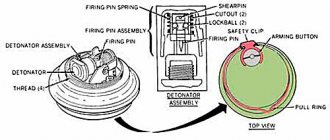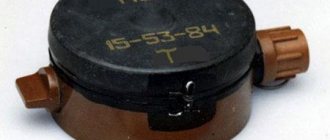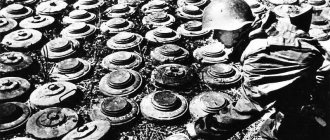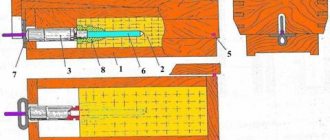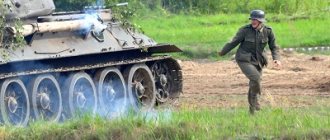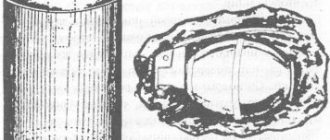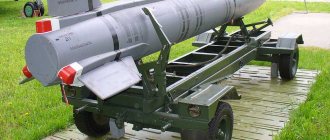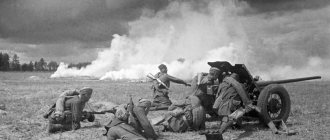Tactical and technical characteristics of the TM-72 mine
— mine-explosive;
- non-explosive;
- combined.
They are anti-tank and anti-personnel. If there are rivers (reservoirs), water barriers can be installed.
According to the method of actuation: controlled, uncontrolled. Mine-explosive barriers form the basis of engineering barriers and are installed in the form of minefields, groups of mine sites and individual mines.
To construct mine-explosive barriers, anti-tank (ATM) and anti-personnel (APM) mines, as well as explosive charges, are used. In combination with mine-explosive barriers, signal mines (SM) can be installed.
Non-explosive barriers are divided into anti-tank and anti-personnel according to their purpose.
Anti-tank ditches include anti-tank ditches, scarps, counter-scarps, gouges (wooden, metal, reinforced concrete, stone), barriers in the forest made of logs and on the banks of reservoirs made of ice, barriers made of metal hedgehogs, barricades in populated areas, snow banks, stripes of icing on mountain slopes , ice holes in rivers and reservoirs, flooded areas, as well as forest debris and rubble in populated areas.
Anti-personnel barriers can be portable or permanent.
Portable wire barriers are used mainly for quickly closing passages, destroyed areas, barriers, and also in cases where the construction of other barriers is difficult. They are usually made in advance and delivered ready-made to the installation site (inconspicuous wire nets, quickly installed barriers made of garlands of barbed and smooth wire, spirals, slingshots and hedgehogs, portable barriers for fighting in a trench).
Permanent barriers include wire nets on high and low stakes, wire fences, thrown wire, snares and loops, notches in the forest, braiding of stumps, bushes with barbed wire, etc.
Anti-tank and anti-personnel non-explosive barriers are used independently, in combination with one another, they can be reinforced with mine-explosive barriers and signaling devices. The location of non-explosive barriers should not be formulaic.
Sections of barriers reinforced with anti-tank and anti-personnel mines are fixed.
When constructing non-explosive barriers, passages are left in them for the passage of friendly troops, and to quickly close these passages, the required number of means (transportable barriers or mines) are provided.
Masking of non-explosive barriers is achieved:
— the correct choice of types of barriers;
— careful application of barriers to the terrain (location of barriers in tall grass, bushes, crops, hollows, ravines, on reverse slopes);
— camouflage painting of barriers structures (hedgehogs, gouges, stakes);
- the use of artificial masks;
- installation of false barriers.
Combined barriers are a combination of mine-explosive and non-explosive barriers.
Testing and measuring instruments M-57, LM-353.
Testing and measuring instruments are designed to measure resistance, check the serviceability of electrical explosive networks, electric detonators, wires and current sources.
Small ohmmeter M-57
Using a small ohmmeter, the conductivity of wires, electric detonators and electrical explosive networks is checked (the ohmmeter needle deviates to the right if they are in good condition or if there is conductivity of the wires and electric detonators being tested), as well as for an approximate measurement of their resistance in the range from 0 to 5000 Ohms.
The small ohmmeter must be checked before use:
— by pressing the button, short-circuit the ohmmeter clamps (1st check). The needle of a working device should deflect to the right to zero. If the arrow does not coincide with the scale zero, rotate the screw on the back wall of the device to bring the arrow to zero. And if this cannot be done, you should replace the battery and check and adjust the ohmmeter again. If the needle does not deflect to zero even after replacing the battery, the device is faulty;
- if during the first check the ohmmeter malfunction is not identified, then during the second check one electric detonator (electric igniter) must be connected to the terminals of the device (with all precautions taken). If no explosion follows, and the arrow on the scale approaches zero, then the device is working properly.
⇐ Previous11Next ⇒
Recommended pages:
Links
- Engineering ammunition. Materials and Application Guide. Book one. -M.: Military Publishing House of the USSR Ministry of Defense, 1976.
- www.arms.ru/mines/tm72.htm
Argentina Argentina FMK-3 FMK-5 Bulgaria Bulgaria Ba-III UK UK Mk 7 Italy Italy TS/6.1 USA USA BLU-91/B Third Reich Third Reich
Creation of OZM-72
After the end of the Great Patriotic War, funding for the design bureau dealing with the development of mine-explosive art increased significantly. After all, sappers and their skills, together with the means of defeating the enemy they used, gave very effective results during the war.
In the 60s, in Balashikha near Moscow, at the Scientific Research Engineering Institute, the development of a new mine that met engineering standards and had high destructive qualities began. By that time, the skill and observation of sappers made it possible to clear most engineering weapons. A new ammunition was needed that was difficult to detect and difficult to deactivate by the enemy.
At the end of the 60s, tests began on the OZM-72, in which a charge activation method was used, distinguishable from the classic version.
The detonation of the charge occurred at a distance of one meter from the ground.
The prototype of the projectile was OZM-152, but this time the designers were given the task of reducing its dimensions while maintaining the damaging qualities of a sapper weapon. The length of the OZM-152 was 60 cm, and this characteristic significantly complicated the effective use of the mine at that time.
The tests lasted until 1972, engineers experimented with the mine's destructive elements. At first these were small cut pieces of metal, but they were soon abandoned, replaced by spherical balls, which doubled the radius of the OZM-72’s solid damage.
When using the standard MUV-3 fuse, it was impossible to clear the mine. This decision was made by the designers in order to prevent it from falling into enemy hands in the event of neutralization, and to ensure that the principle of operation of the engineering projectile remained a secret. Therefore, the OZM-72 with the fuse cocked in the firing position could only be neutralized by detonation. In 1973, OZM-72 was put into service.
Combat use
This mine began to be considered a very powerful weapon after its first combat use. It took place during the war in Afghanistan under tragic circumstances.
On April 20, 1984, in the Panjshir Gorge, during a military operation, paratroopers of the 2nd Parachute Battalion of the 345th Parachute Regiment landed. The OZM-72 mine, installed during previous hostilities, detonated. According to some reports, several dozen people became victims, although such losses are not listed in official reports. According to legend, after this the soldiers nicknamed the OZM-72 mine “The Witch.”
In Afghanistan, OZM-72 caused a lot of trouble for local resistance forces.
There are known cases when groups of reconnaissance and special forces, having completed a combat mission, planted a mine in advance on the retreat routes, on the way to the assembly point. The “spirits” chasing Soviet soldiers blew themselves up on it and died in dozens and stopped the pursuit.
The engineering shell was also actively used by federal troops during the first and second Chechen campaigns. Until the end of the 90s, the principle of operation of the mine was not clear to opponents. So, when the OZM-72 fell into the hands of the militants, they blew themselves up with it, trying to install it on the ground. Also, some sappers used the OZM-72 as an assault grenade when fighting in the city.
It was especially effective when liberating a building from the enemy, who occupied the upper floors of high-rise buildings. To do this, the cable connecting the bottom cover and the charge was unfastened or cut. Under the influence of the expelling charge, the striking elements of the OZM-72 jumped to a height of 18-20 meters, where detonation occurred.
History of the development of mine demolition art in the Soviet Union
Technical progress after the end of the First World War advanced by leaps and bounds. There was an open arms race; every year the leading countries produced new models of aircraft and tanks. The latter developed especially actively, and that is why the main direction of progress in mine-explosive art in the 20-30s. was conducting research in the field of use of anti-tank mines.
The evolution of anti-personnel mines of that time was limited to the use of MUV (mine universal fuze) on engineering weapons.
This fuse was and remains the only fuse of its type that allowed charge neutralization. But not all types of mines can be neutralized due to the design features of the projectile.
Those that allowed the sapper to clear them required putting a special clip on the MUV rod. After which a safety pin was inserted into a special hole, and the fuse could not detonate. And after carrying out such simple actions, it was possible to remove the fuse itself from the mine body.
Thanks to the MUV, anti-personnel mines could operate in two modes - tension and pressure. To operate in tension mode, it was necessary to touch a tensioned cable, which was connected to the fuse that detonated the charge. In the second mode, the explosion occurred after direct contact of the enemy with the pressure surface of the mine - a button that initiated the detonation of the MUV, detonating the filling of the projectile.
Having created such universal fuses, the command relied on graduates of the Petrograd College and their skills. As planned by the commanders, specialists, if necessary, had to independently assemble a mine from improvised means. It had to comply with the tactical standards of those times, and the MUV was supposed to facilitate the task of detonating engineered weapons.
This use of graduates’ skills proved ineffective, and in 1939, the DP-1 anti-personnel landmine was invented in an engineering laboratory. A little later, sappers received at their disposal the OMZ-152, a powerful fragmentation-type projectile with an expulsion chamber under the influence of a powder charge.
Even later, during the war with Finland, the Soviet army received the POMZ, a super-effective tension-type mine. According to some versions, it was the development of Soviet-German designers. This theory has a right to exist, since in 1940 the German engineering troops received a complete analogue of the POMZ - the Stockmain combined arms anti-personnel mine.
In 1940, Soviet sappers received two more excellent mines.
PMK-40 weighed only 90 grams, and the charged explosive was powdered TNT. The task of another product, designated PMM-6, was to effectively incapacitate enemy personnel traveling on skis.
In addition to the above-mentioned weapons, the engineering troops are approaching the beginning of the Great Patriotic War with a wide selection of standard explosive means in their arsenal. This made it possible to revive the hitherto ineffective tactics of collecting mines in the field.
Design and principle of operation of OZM-72
A thin metal sleeve with round caps at both ends is inserted into a steel cup (mine body), which is shaped like a cylinder. OZM-72 lids are simultaneously the upper and lower parts of the glass (bottom and ceiling).
The top cover contains a KV-11 igniter primer, equipped with a protective cap against spontaneous ignition.
There is also a threaded hole provided for installing a detonator capsule. Both covers fit tightly to the OZM-72 body, are sealed and prevent air and moisture from entering the body cavity.
At the bottom of the tube connecting the lower and upper covers there is an OZM-72 expelling charge - black (smoke) powder in a moisture-resistant bag. Just below there is a striking mechanism. The volume of the OZM-72 body is filled with a charge, which consists of 2400 metal balls packed in a dense plastic bag.
At the bottom of the OZM-72 body, immediately above the bottom cover, there is a cable attached to it, laid in a special chamber. Its length ranges from 500 to 900 cm. To install a mine, it is necessary to have two tension cables. Both elements are connected to the fuse, and are supplied with connecting wire and carabiners. With their help, a mine is mounted on a piece of terrain.
To install OZM-72 tension cables on the ground, wooden and metal pegs are required. A fuse of type MUV-3 or MUV-4 is screwed onto a hole in the connecting tube.
When the OZM-72 fuse detonates, an additional powder charge (tetryl) is ignited.
He ignites the black powder in the bag located at the bottom of the tube. The resulting gases eject a combat charge filled with fragment balls from the cylindrical base of the OZM-72 mine. It flies up to 1 meter above the ground and explodes, hitting all objects around it located within a radius of 25 meters.
